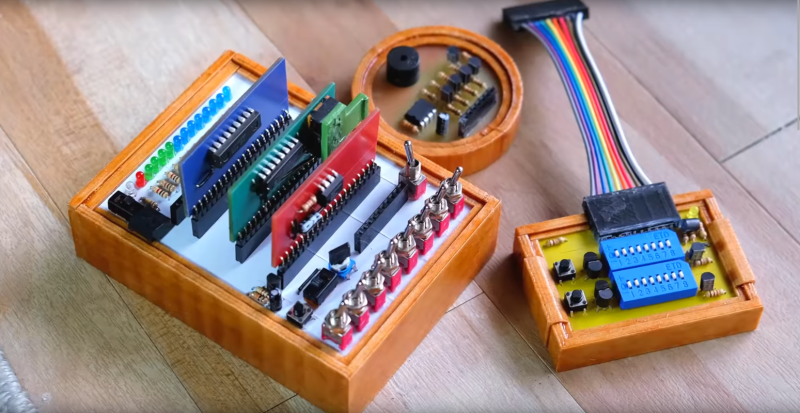Building a retro computer of some sort is a rite of passage for many of us, with some building replicas or restorations of old Commodores, Ataris, and other machines from decades past. Others go even further back, to the time of the Intel 8008 or earlier, and a dedicated few will build something completely novel. This project from [3DSage] falls squarely in the latter category, with his completely DIY computer built component by component from scratch, including the machine code needed to run it.
[3DSage] starts with the backbone of every computer: the clock. He first demonstrates how a pair of NOT gates with a set of capacitors can be used as a rudimentary clock pulse, then builds a more refined version with a 555 timer and potentiometer for adjustable rates. Then, it’s on to creating a binary counter, which is a fundamental part of the memory system for this small computer, and finally, allows this circuitry to behave like a normal computer. Using a set of switches to store values in memory and stepping through them with the clock, the computer can be programmed to do plenty of tasks just like a modern microcontroller.
[3DSage] built this project a few years ago and has used it for real-world applications such as controlling servos, LED arrays, playing music, and other tasks. Although he has to program it using his own machine code by hand, it’s a usable computer in many ways. If you want to eschew modernity and build a retro computer in the style of the 1960s, though, this piece goes through what it would have been like to build a similar system in the era when these computers were more common. If you have a switch fetish, you might like to see how real computers worked back then, too.

















I think that it is a sequencer rather than a computer. No ALU, no conditonal jumps, did not see any method to writing RAM except the switches. Nice looking project though.
… But, it’s a good start toward that end. Build on!
There’s no schematic, no writeup, no nothing. I guess this thing was just built to amuse >110k subscribers and will be abandoned as soon as they get bored.
This is a sad trend (not only) in HaD articles. People dont bother to write articles, just make videos with 90% unnecessary content.
For this kind of project, I would like to see a schematic, and directly from that see how the device works, instead of looking a long video on how a counter can force itself to a new address or stop the clock, by addressing a preprogrammed RAM.
This could be a base for microprogram sequencer, but very far from an actual computer. Not wanting to turn down the author, a programmable sequence generator is useful, and we all like flashing LEDs in a nicely made cabinet. But with a same amount of LEDs and switches, real computers (not Raspberry Pi emulations) have been made to fit into an Altoids tin.
I’m always going to be impressed by anone who can build a computer out of ground up stuff.
Yeah, I wonder what kind of adhesive he used?
If you’re reading this comment, then this course and book will probably be of interest to you. Fascinating stuff to me. :-)
https://www.nand2tetris.org/
Reminded me of James Sharman
https://youtube.com/playlist?list=PLFhc0MFC8MiCDOh3cGFji3qQfXziB9yOw&si=OvkdgV_lBq5VyM_l
This reminded me of the scratch-build that turned on the lights for me as to how computers worked:
https://archive.org/details/byte-magazine-1977-11/page/n77/mode/2up
I bought a copy of that Byte on eBay and might one day give it (or something like it) a go for old times’ sake.
I like BHDIK for instructions to build a computer from scratch. 8 bit instruction set, all from NAND gates.
A great teaching aid.
Some of us grew up before micro’s, and learning about discrete logic was a necessity.
I particularly love the flip clock binary counter !
So he did NOT mine the raw materials himself?!
Amateur.